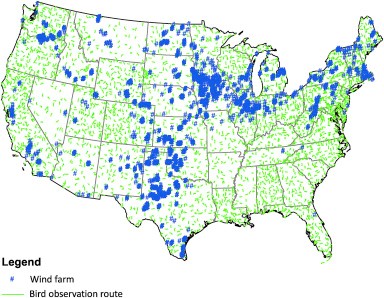Wind energy is considered a promising alternative to fossil fuels that cause air pollution and contribute to global warming. Since 2000 wind energy has become one of the fastest-growing sources of renewable energy in the United States (U.S. DOE). In 2018, wind power generated about 7% of total electricity and about 39% of renewable electricity across the nation (U.S. EIA).
However, a recent study conducted by a group of researchers from Auburn University and the University of Illinois at Urbana–Champaign finds that onshore wind farms (as shown in the map below), can be held responsible for the disappearance of about 151,630 breeding birds.

Based on the Breeding Bird Survey (BBS) data compiled by the U.S. Geological Survey (the bird survey routes are shown as green lines in the map above), the study finds that the establishment of a wind turbine within a 400-meter radius of an observation route, on average, leads to disappearance of three breeding birds there. However, if the turbine stays about 800 meters away from the route then it may cause disappearance of about two birds. This effect fades away if the turbine is installed over 1,600 meters away from a route.
The study also aims to distinguish the impact of turbine height and that of blade length on bird abundance. It finds that taller turbines can be considered more friendly toward breeding birds while longer blades can be considered more detrimental to those birds. For instance, everything else equal, if all turbines within a 400 mile radius of a route were to become 1-meter taller, then the bird counts along one observation route would increase by about 8. On the other hand, if the blade length were to increase by 1 meter, then the bird count along a route would decrease by 16. These effects fade away if wind turbines are located over 1,600 meters away from an observation route. This finding suggests that wind energy developers should consider siting wind farms at least one-mile away from high density bird habitats.
This study also sheds light on wind turbines’ impact on grassland birds, which have been disappearing at a fast rate in the Unites States. The study finds that, unlike aggregate breeding bird species, grassland birds may benefit from the nearby wind turbines, perhaps because the density of predators is reduced around turbines. This indicates that the impact of wind turbines are heterogeneous among bird species.
Given that wind turbines are becoming taller and larger to improve the efficiency of energy generation (U.S. EIA), this study reveals a tradeoff between biodiversity and electricity generation. To minimize the adverse impact of wind turbines on breeding birds, policies could encourage more R&D to facilitate taller turbine towers with shorter blades that will still efficiently produce more wind energy in the coming days.
Miao, R., Ghosh, P.N., Khanna, M., Wang, W. and Rong, J., 2019. Effect of wind turbines on bird abundance: A national scale analysis based on fixed effects models. Energy Policy, 132, pp.357-366. Available at https://www.sciencedirect.com/science/article/pii/S0301421519302897#!

